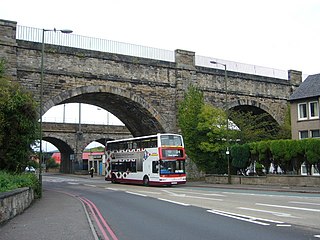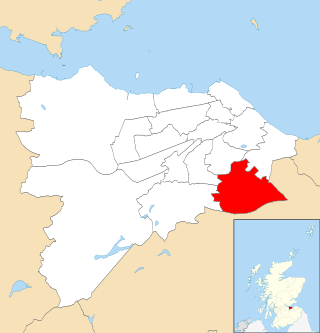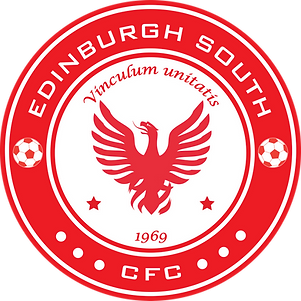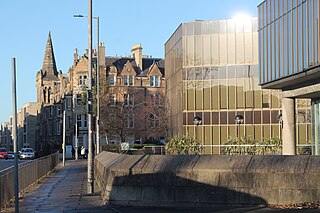
Midlothian is a historic county, registration county, lieutenancy area and one of 32 council areas of Scotland used for local government. Midlothian lies in the east-central Lowlands, bordering the City of Edinburgh council area, East Lothian and the Scottish Borders.

Dalkeith is a town in Midlothian, Scotland, on the River Esk. It was granted a burgh of barony in 1401 and a burgh of regality in 1540. The settlement of Dalkeith grew southwestwards from its 12th-century castle . Dalkeith has a population of 12,342 people according to the 2011 census.

The Edinburgh City Bypass, designated as A720, is one of the most important trunk roads in Scotland. Circling around the south of Edinburgh, as the equivalent of a ring road for the coastal city, it links together the A1 towards north-east England, the A702 towards north-west England, the M8 through the Central Belt towards Glasgow, the A7 through south-east Scotland and north-west England as well as the A8 leading to the M9 for Stirling and the Queensferry Crossing.

Toryglen is a district in southern Glasgow, Scotland, falling within the Langside ward under Glasgow City Council. It is approximately two miles south of the city centre, bounded to the west by Mount Florida, the north-west by Polmadie, to the north-east by the West Coast Main Line railway and the M74 motorway the south by King's Park, and immediately to the east by the town of Rutherglen.

Newington is a neighbourhood of southern Edinburgh, Scotland. Developed from the early 19th century, it is an affluent, predominantly residential area.

Inverleith is an inner suburb in the north of Edinburgh, Scotland, on the fringes of the central region of the city. Its neighbours include Trinity to the north and the New Town to the south, with Canonmills at the south-east and Stockbridge at the south-west.
Sighthill is a suburb in the west of Edinburgh, Scotland. The area is bordered by Broomhouse and Parkhead to the east, South Gyle to the north, the industrial suburb of Bankhead and the Calders neighbourhood to the west, and Wester Hailes to the south. It is sometimes included in the Wester Hailes area, while the Calders, Bankhead and Parkhead are sometimes considered parts of Sighthill. Administratively it has formed a core part of the City of Edinburgh Council's Sighthill/Gorgie ward since 2007.

Cameron Toll is a suburb located to the south of Edinburgh, Scotland. Originally it was the site of a toll house built in the early 19th century, which was located on a stretch of road between Edinburgh and Dalkeith. Today the area is home to Cameron Toll Shopping Centre, which opened in 1984. The meaning of the name Cameron is suggested to be 'crooked hill', derived from the Scots Gaelic 'cam', crooked, and Old Irish 'brun' meaning hill, believed to refer to Arthur's Seat clearly visible nearby; the original name may have been Pictish. There are a few small housing estates to the east of the area.

Longstone is a suburb of Edinburgh in Scotland. The area is primarily residential in nature, although the area includes several small shops, eateries and supermarkets, as well as one of the main bus depots for the city's buses. The population of Longstone was 4,678 in 2019.
Fernieside is a neighbourhood on the southern edge of the city of Edinburgh, Scotland, four miles (6.5 km) southeast of the city centre. It is very close to Craigour, which is just to its north, with Ferniehill to the south, Moredun to the west and open land to the east denoting the city boundary ; most amenities are found at Gilmerton. Laid out as public housing from 1947, many properties have been sold through right-to-buy legislation, while small private developments have been inserted to the north in the early 21st century.

Gilmerton is a suburb of Edinburgh, about 4 miles (6.4 km) southeast of the city centre.

Liberton is a suburb of Edinburgh, the capital of Scotland. It is in the south of the city, south of The Inch, east of the Braid Hills and west of Moredun.

Dumbiedykes is a residential area in the centre of Edinburgh, Scotland. It mainly comprises public housing developments.

The A772 was a major A road located in Edinburgh, Scotland. The A772 was originally the A7 before a major renumbering of the roads into Edinburgh and also begins there, at a junction with the A701 in the neighbourhood of Nether Liberton. From this junction, the A772 heads south-east through Gilmerton, a suburb of Edinburgh. This part is known as Gilmerton Road and has a 30 mph speed limit. At the edge of Gilmerton, the road becomes Drum Street, where it passes The Drum, an 18th-century country house, before reverting to Gilmerton Road.

Lochend Park is a public park in Edinburgh, Scotland. It is situated in the Lochend / Restalrig area, next to Lochend Castle and near Meadowbank Stadium. The loch with its wide range of waterfowl is the main attraction, but there are also historical buildings, a children's play area, and sports areas. The park was awarded a Green Flag in 2012 in recognition of it being a quality greenspace. Within the park there is a 16th-century doocot which is Category B listed.

Westburn is a district of the town of Cambuslang in South Lanarkshire, Scotland. It was formerly home to a steel works and power station which were the area's major employers; the sites are now occupied by a housing development and modern industrial estate respectively. Administratively, Westburn is within the Cambuslang East ward of the South Lanarkshire Council area and has a population of around 2,000.

Inch House, a former country house situated within Inch Park in Edinburgh, Scotland is a category A listed building. The oldest part, a Scottish vernacular L-plan tower house, dates from the early 17th century. From 1660 it was owned by the Gilmour family, who arranged for additions and extensions to the house in the 18th and 19th centuries. It was sold to the then Edinburgh Corporation in 1945. Since then it has been used as a primary school and more recently as a community centre.

Liberton/Gilmerton is one of the seventeen wards used to elect members of the City of Edinburgh Council. Established in 2007 along with the other wards, it elects four Councillors.

Edinburgh South Community Football Club is a Scottish football club based in the Inch district of south-eastern Edinburgh. Formed as a youth club in the 1960s, they successfully applied to have a senior team enter the East of Scotland Football League for the 2020–21 season as Edinburgh South FC.

St Leonard's is a neighbourhood of south-central Edinburgh, Scotland, United Kingdom. Once notable as a centre of industry, it is now primarily residential.

























